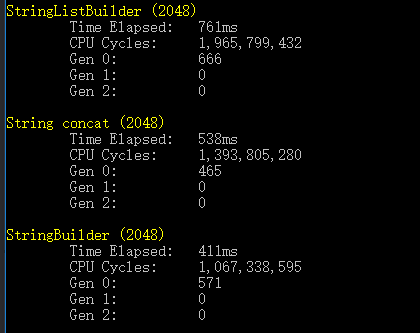从.Net版本演变看String和StringBuilder性能之争
在C#中string关键字的映射实际上指向.NET基类System.String。System.String是一个功能非常强大且用途非常广泛的基类,所以我们在用C#string的时候实际就是在用.NET Framework String。String上是一个不可变的数据类型,一旦对字符串对象进行了初始化,该字符串对象就不能改变了。表面上修改字符串内容的方法和运算符实际上创建一个新字符串,所以重复修改给定的字符串,效率会很低。所以.Net Framework定义了另一个StringBuild类以提高字符串处理的性能,但String和StringBuild之间又有什么联系呢。
以下一个示例基于版本.Net Framework2.0这个示例主要是参考重谈字符串性能,先定义一个简单性能计数器主要目的有:
(1)打印出各字符串处理方法的消耗时间
(2)CPU时钟周期
(3)执行过程中垃圾回收器回收次数
public class CodeTimer { public delegate void Action(); /// <summary> /// 初始化 /// </summary> public static void Initialize() { Process.GetCurrentProcess().PriorityClass = ProcessPriorityClass.High; Thread.CurrentThread.Priority = ThreadPriority.Highest; Time("", 1, () => { }); } public static void Time(string name, int iteration, Action action) { if (String.IsNullOrEmpty(name)) return; // 1. ConsoleColor currentForeColor = Console.ForegroundColor; Console.ForegroundColor = ConsoleColor.Yellow; Console.WriteLine(name); // 2. GC.Collect(GC.MaxGeneration, GCCollectionMode.Forced); int[] gcCounts = new int[GC.MaxGeneration + 1]; for (int i = 0; i <= GC.MaxGeneration; i++) { gcCounts[i] = GC.CollectionCount(i); } // 3. Stopwatch watch = new Stopwatch(); watch.Start(); ulong cycleCount = GetCycleCount(); for (int i = 0; i < iteration; i++) action(); ulong cpuCycles = GetCycleCount() - cycleCount; watch.Stop(); // 4. Console.ForegroundColor = currentForeColor; Console.WriteLine("\tTime Elapsed:\t" + watch.ElapsedMilliseconds.ToString("N0") + "ms"); Console.WriteLine("\tCPU Cycles:\t" + cpuCycles.ToString("N0")); // 5. for (int i = 0; i <= GC.MaxGeneration; i++) { int count = GC.CollectionCount(i) - gcCounts[i]; Console.WriteLine("\tGen " + i + ": \t\t" + count); } Console.WriteLine(); } private static ulong GetCycleCount() { ulong cycleCount = 0; QueryThreadCycleTime(GetCurrentThread(), ref cycleCount); return cycleCount; } [DllImport("kernel32.dll")] [return: MarshalAs(UnmanagedType.Bool)] static extern bool QueryThreadCycleTime(IntPtr threadHandle, ref ulong cycleTime); [DllImport("kernel32.dll")] static extern IntPtr GetCurrentThread(); }
原文链接:一个简单的性能计数器:CodeTimer
定义一个StringListBuilder用List<string>先将所有字符串保存起来最后转化为字符串数组,再返回字符串
public class StringListBuilder { private List<string> m_list = new List<string>(); public StringListBuilder Append(string s) { this.m_list.Add(s); return this; } public override string ToString() { return String.Concat(this.m_list.ToArray()); } }
定义一个StrPerformance类用于维护各个字符串处理的方法

public class StrPerformance { private static readonly string STR = "0123456789"; public static string NormalConcat(int count) { var result = ""; for (int i = 0; i < count; i++) result += STR; return result; } public static string StringBuilder(int count) { var builder = new StringBuilder(); for (int i = 0; i < count; i++) builder.Append(STR); return builder.ToString(); } public static string StringListBuilder(int count) { var builder = new StringListBuilder(); for (int i = 0; i < count; i++) builder.Append(STR); return builder.ToString(); } public static string StringConcat(int count) { var array = new string[count]; for (int i = 0; i < count; i++) array[i] = STR; return String.Concat(array); } }
用性能计数器记录各个方法执行过程并且打印出对应的参数
CodeTimer.Initialize(); for (int i = 2; i <= 2048; i *= 2) { CodeTimer.Time( String.Format("StringListBuilder ({0})", i), 10000, () => StrPerformance.StringListBuilder(i)); CodeTimer.Time( String.Format("String concat ({0})", i), 10000, () => StrPerformance.StringConcat(i)); CodeTimer.Time( String.Format("StringBuilder ({0})", i), 10000, () => StrPerformance.StringBuilder(i)); }

分析可以得出,广受追捧的StringBuilder性能似乎并不是最好的,String.Concat方法有时候有时候更适合使用。那么为什么String.Concat方法性能那么高,StringBuilder反而比StringListBuilder要差,要知道StringListBuilder还要维护一个集合,通过反编译我们看一下.NET2.0的String.Concat和StringBuilder到底是怎么实现的。
先看在.Net2.0下StringBuilder的Append和ToString方法的实现过程,Append和ToString实现过程。

// System.Text.StringBuilder public StringBuilder Append(string value) { if (value == null) { return this; } string text = this.m_StringValue; IntPtr intPtr = Thread.InternalGetCurrentThread(); if (this.m_currentThread != intPtr) { text = string.GetStringForStringBuilder(text, text.Capacity); } int length = text.Length; int requiredLength = length + value.Length; if (this.NeedsAllocation(text, requiredLength)) { string newString = this.GetNewString(text, requiredLength); newString.AppendInPlace(value, length); this.ReplaceString(intPtr, newString); } else { text.AppendInPlace(value, length); this.ReplaceString(intPtr, text); } return this; }

public override string ToString() { string currentValue = this.m_currentValue; if (this.m_currentThread != Thread.InternalGetCurrentThread()) { return string.InternalCopy(currentValue); } // 如果这个字符串对象“太空”的话 if ((2 * currentValue.Length) < currentValue.ArrayLength) { // 则构造一个“满当”地对象 return string.InternalCopy(currentValue); } // 将字符序列最后放一个\0 currentValue.ClearPostNullChar(); // 既然容器已经“暴露”,则设制“当前线程”的标识为Zero, // 这意味着下次操作会生成新字符串对象(即新的容器) this.m_currentThread = IntPtr.Zero; // 如果“还不算太空”,则返回当前对象 return currentValue; }
StringBuilder的ToString方法比较有意思,它会判断到底是“构造一个新对象”还是就“直接返回当前容器”给你。如果直接返回当前容器,则可能会浪费较多内存,而如果构造一个新对象,则又会损耗性能。让StringBuilder做出决定的便是容器内部的字符序列占“最大容积”的比例,如果超过一半,则表明“还不算太空”,便选择“时间”,直接返回容器;否则,StringBuilder会认为还是选择“空间”较为合算,便构造一个新对象并返回,至于当前的容器便会和StringBuilder一道被GC回收了。
同时我们可以看到,如果返回了新对象,则当前容器还可以继续在Append时使用,否则Append方法便会因为m_currentValue为Zero而创建新的容器。不过,从ToString的实现中也可以看出,多次调用ToString方法一定返回新建的对象。
而String.Concat又做了什么,String类Concat的具体实现过程

public static string Concat(params string[] values) { int totalLength = 0; if (values == null) { throw new ArgumentNullException("values"); } string[] arrayToConcate = new string[values.Length]; // 遍历源数组,填充拼接用的数组 for (int i = 0; i < values.Length; i++) { string str = values[i]; // null作为空字符串对待 arrayToConcate[i] = (str == null) ? Empty : str; // 累计字符串总长度 totalLength += arrayToConcate[i].Length; // 如果越界了,抛异常 if (totalLength < 0) { throw new OutOfMemoryException(); } } // 拼接 return ConcatArray(arrayToConcate, totalLength); }

[MethodImpl(MethodImplOptions.InternalCall)] private static extern string FastAllocateString(int length); private static string ConcatArray(string[] values, int totalLength) { // 分配目标字符串所占用的空间(即创建对象) string dest = FastAllocateString(totalLength); int destPos = 0; for (int i = 0; i < values.Length; i++) { // 不断将源字符串的每个元素填充至目标位置 FillStringChecked(dest, destPos, values[i]); // 偏移量不断更新 destPos += values[i].Length; } return dest; }

private static unsafe void FillStringChecked(string dest, int destPos, string src) { int length = src.Length; if (length > (dest.Length - destPos)) { throw new IndexOutOfRangeException(); } fixed (char* chDest = &dest.m_firstChar) { fixed (char* chSrc = &src.m_firstChar) { wstrcpy(chDest + destPos, chSrc, length); } } }
由于数组中的字符串都是确定的因此事先计算出结果的长度,于是遍历源字符串数组,将它们一个一个复制(或叫做“填充”)到目标字符串的某一段位置上去,因为在此之前已经确定结果的大小,因此直接创建一个“容器”即可,剩下的只是填充数据而已。既然可以不浪费任何一寸空间,也没有任何多余的操作,这也是String.Concat高效的原因。
同样的代码移植到.Net 4.5上会不会还像之前一样String.Concat在处理连接字符串中性能最高

这次StringBuilder又重新回到了我们最初的印象中,在处理多字符串连接的时候StringBuilder是性能最高的,通过和.Net 2.0的实验结果来看StringListBuilder和String Concat的性能变化不大,而似乎StringBuilder的性能提高了一倍,那么在.NET 4.5中StringBuilder的Append方法又做了什么呢,下面我们来看一下.Net 4.5中Append的具体实现过程
public unsafe StringBuilder Append(string value) { if (value != null) { //StringBuilder内维护的一个字符数组 char[] chunkChars = this.m_ChunkChars; int chunkLength = this.m_ChunkLength; int length = value.Length; int num = chunkLength + length; //不必增加m_ChunkChars字符数组的长度 if (num < chunkChars.Length) { if (length <= 2) { if (length > 0) { chunkChars[chunkLength] = value[0]; } if (length > 1) { chunkChars[chunkLength + 1] = value[1]; } } else { fixed (string text = value) { char* ptr = text; if (ptr != null) { ptr += RuntimeHelpers.OffsetToStringData / 2; } fixed (char* ptr2 = &chunkChars[chunkLength]) { string.wstrcpy(ptr2, ptr, length); } } } this.m_ChunkLength = num; } //增加m_ChunkChars数组的长度 else { this.AppendHelper(value); } } return this; }

private unsafe void AppendHelper(string value) { fixed (string text = value) { //去字符串的地址 char* ptr = text; if (ptr != null) { ptr += RuntimeHelpers.OffsetToStringData / 2; } this.Append(ptr, value.Length); } } public unsafe StringBuilder Append(char* value, int valueCount) { if (valueCount < 0) { throw new ArgumentOutOfRangeException("valueCount", Environment.GetResourceString("ArgumentOutOfRange_NegativeCount")); } int num = valueCount + this.m_ChunkLength; if (num <= this.m_ChunkChars.Length) { //把字符串一个一个复制到m_ChunkChars字符数组中 StringBuilder.ThreadSafeCopy(value, this.m_ChunkChars, this.m_ChunkLength, valueCount); this.m_ChunkLength = num; } else { int num2 = this.m_ChunkChars.Length - this.m_ChunkLength; if (num2 > 0) { StringBuilder.ThreadSafeCopy(value, this.m_ChunkChars, this.m_ChunkLength, num2); this.m_ChunkLength = this.m_ChunkChars.Length; } int num3 = valueCount - num2; this.ExpandByABlock(num3); StringBuilder.ThreadSafeCopy(value + num2, this.m_ChunkChars, 0, num3); this.m_ChunkLength = num3; } return this; }
在分析代码可知在.Net 4.5StringBuilder中内部维护了一个m_ChunkChars字符数组,来避免不断扩容,不断复制的过程所造成的性能消耗,所以StringBuilder性能又成为三者中最高的一个。
看了老赵blog之后,(此处省去一千溢美之词)——只想说一句:“我对阁下的景仰有如滔滔江水,连绵不绝,又如黄河泛滥,一发而不可收拾!



 浙公网安备 33010602011771号
浙公网安备 33010602011771号